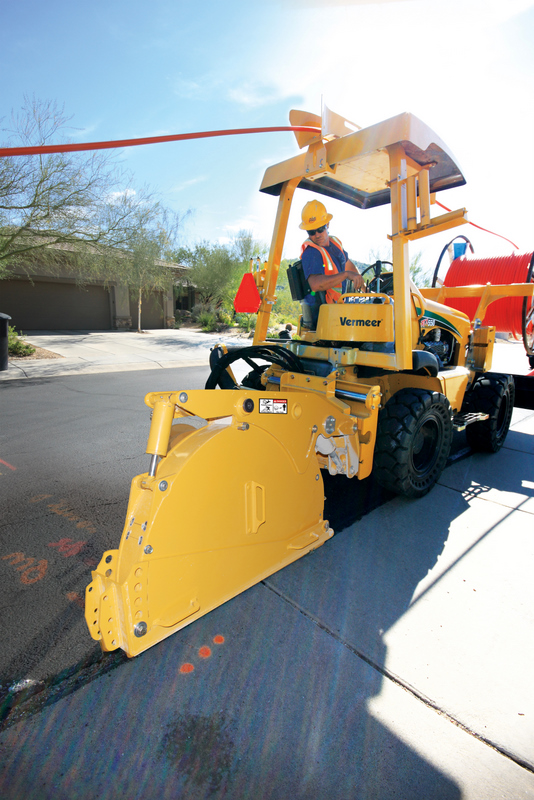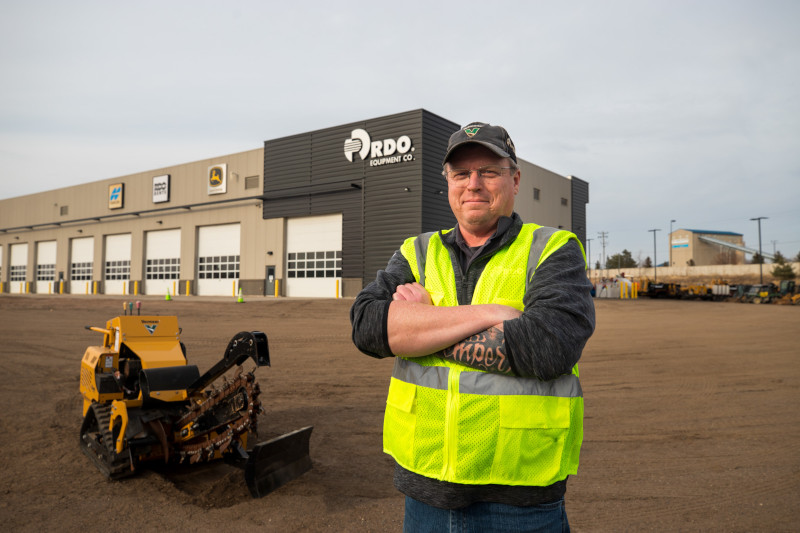CONEXPO Cometh: The Vermeer Microtrencher Installs Fiber in Quick and Efficient Passes (Video)

The utility equipment magnate Vermeer actually introduced us to the application at CONEXPO-CON/AGG last week, with its MTR12 and MTR16 microtrenching attachments (fitted to its Vermeer RTX550 utility tractor). Microtrenching is an installation method in which a narrow (.75 to 2.25 in. [19.1 – 57.2 mm]) and relatively shallow trench (8 to 16 in. [20.3 to 40.6 cm]) is cut, typically on one side of a roadway. Then a vacuum system connected to the cutter wheel attachment diverts and transports the dry and dusty spoil away from the worksite. Once the conduit pipe is laid, the trench is backfilled with a grout compound. An asphalt sealer may then be used to finish the cut flush with the surface.
“We listening to utility contractor needs,” says Jon Kuyers, utility segment manager for Vermeer. “Then we took that information and conducted extensive field tests to validate our design and find the right combination of features to help contractors enhance jobsite productivity.”
The Vermeer microtrenching system consists of four main components — the cutter wheel, utility tractor, vacuum and grout mixer — creating a “train” to complete the installation in one pass.
The MTR12 and MTR16 microtrenching attachments offer maximum cutting depths of 12 (30.5) and 16 in. (40.6 cm) respectively, and depth control is mechanically adjusted in 1-in. (2.5-cm) increments. A spring-loaded, flex pivot design and patent-pending guide aid steering, particularly around shallow curves, and a lift and level design keeps the attachment flush with the surface to maximize cutter wheel engagement and vacuum performance when uneven conditions are encountered.
Vermeer offers a range of cutter wheel configurations to meet project specifications and contractor preferences. The Vermeer-exclusive Yellow Jacket cutter system offers teeth with reversible cutting edges. When one edge is worn, simply flip the tooth to access a new cutting edge to help maximize tooth life and increase cutting time between tooth change out. Rotary tooth and shark tooth configurations are available for wider and narrow cutting specifications respectively.
The attachments are designed to work with the Vermeer RTX550 utility tractor, which features electronic ground drive control with auto creep for precise tractor and attachment control. The specially-configured tractor is equipped with solid rubber tires to reduce bounce. A 1500-lb (680.4-kg) maximum capacity reel carrier is also available that helps reduce the need for additional support equipment.
Dry and dusty spoil from the cutter wheel can be diverted from the worksite using a McLaughlin V500LE high-cfm vacuum system. A standard three-stage filtration system with cyclone separator is more efficient in handling dry material than other filtration systems. An optional misting ring minimizes fine dust particles, helping to extend dumping cycle time and boosting vacuum performance.
The trench is backfilled with a grout compound using a wheeled application wand. Vermeer offers its GM30 grout mixer with a 60-gal. (227.1-L) capacity that can fill up to a 90-ft (27.4-m) by 1-in. (2.5-cm) wide by 12-in. (30.5-cm) deep trench with each batch.
For more information on Vermeer products and services, visit the company’s website at www.vermeer.com or e-mail Vermeer at salesinfo@vermeer.com. Want to see the machine on the show floor, check out the video below.





Comments are closed here.